T-Platforms, a global supplier of supercomputer and HPC solutions, has announced recently that the company has been selected by the M.V.Lomonosov Moscow State University for building a computer cluster capable of 10 PFlops performance.
The system is destined to be used for supporting fundamental scientific and application research in aerospace, nuclear, biomedical, oil and gas, and many other industries.
Its specifications were not yet revealed, but the Moscow State University is already operating two system built by T-Platforms, the latter being capable of 1.3 PFlops performance and being deployed in March of this year.
If its specs are anything to go by, then the 10 PFlops Lomonosov HPC cluster is expected to come as a hybrid design which brings together the power of traditional processors with that of general purpose GPUs.
"We have enjoyed close cooperation with M.V. Lomonosov Moscow State University for many years, and it is appropriate to describe MSU as a strategic partner for our company," said Vsevolod Opanasenko, CEO of T-Platforms.
"We consider this selection a competitive victory, and we are honored to design a new generation computer system with record-breaking performance for our country.
“This is a strong confirmation of the highest expertise of our engineers and developers by the largest Russian Scientific Centre.
“Creating this system will mark a new stage in development of a domestic supercomputing industry and provide fundamental new possibilities for Russian science," concluded the company’s rep.
T-Platforms hasn’t mentioned when this new supercomputer will go live, but Russia’s plans to exascale computing calls for such a system to be fully operational in 2014-2015.
So far, the world’s fastest HPC system is the Fujitsu-built “K Computer” that has already surpassed the 10 PFlops barriers in the LINPACK benchmark.
The system is comprised out of 864 racks including a total of 88,128 interconnected Fujitsu Sparc64 VIIIfx CPUs and uses a special interconnect called Tofu that is a 6-D mesh/torus capable of providing 5 GBytes/s of bandwidth.

 14 DAY TRIAL //
14 DAY TRIAL //